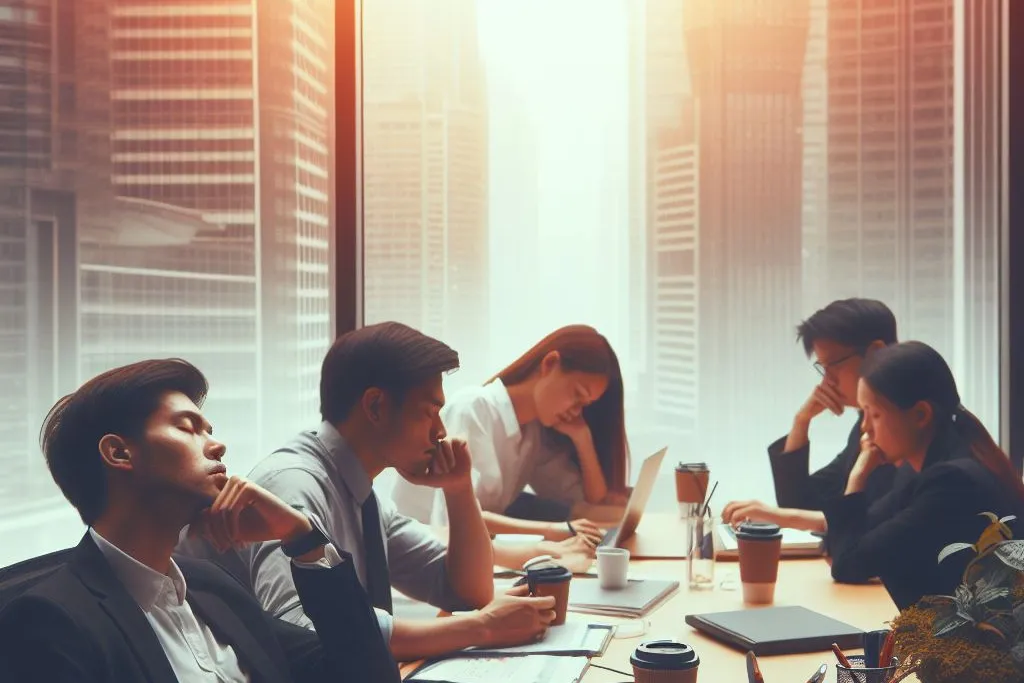Looking for ways to improve the sleep scores or just save some time? Check out how to boost the day with a bit of shut eye!

This article is a part of a series. Check them out all!
In most countries, napping during work hours is not only discouraged but can lead to termination of employment.
Japan, however, presents a unique case. Here, office napping is both commonplace and accepted by society. Interestingly, it’s often seen as a subtle indicator of dedication, implying an employee is working to the point of exhaustion.
The term for this practice is ‘inemuri,’ which is frequently translated as ‘sleeping on the job.’ However, a more precise translation should be: ‘sleeping while present.’
Who can practice Inemuri?
Inemuri better reflects the Japanese view of time, where accomplishing multiple tasks simultaneously, albeit at a reduced intensity, is considered possible.
It is most prevalent among senior white-collar workers. Junior employees, on the other hand, tend to prioritize staying awake throughout the day to project an image of energy, and assembly line workers are naturally restricted from napping due to the nature of their work.
While both genders partake in inemuri, women are more likely to face criticism for it, particularly if their sleeping posture is deemed inappropriate.
Public napping, particularly on crowded commuter trains which effectively transform into impromptu bedrooms, is remarkably widespread in Japan. The country’s exceptionally low crime rate must help a lot having naps on the trains. The likelihood of theft targeting sleeping passengers on trains is very low.
Remarkably, social situations may even see one’s reputation enhanced by sleep. If someone at a dinner party fell asleep at the table, instead of disapproval, other guests appreciate his ‘gentlemanly behavior’ for prioritizing remaining present, albeit asleep, rather than leaving.
One potential explanation for such widespread public sleep behavior in Japan could be insufficient sleep at home. A government study conducted in 2015 revealed that nearly 40% of Japanese adults obtain less than six hours of sleep per night.
An unspoken rule of inemuri dictates maintaining a compact sleeping posture to avoid ‘violating spatial norms’. Disruptive behavior would be exemplified by sprawling out under a conference room table, occupying multiple seats on a train, or lying flat on a park bench.

Why We Should All Do Inamuri?
Drawing a comparison to Western practices, the Japanese concept of inemuri can be likened to the power nap. Both practices aim for a swift recharge, replenishing energy reserves through a short sleep period, typically lasting up to 20 minutes.
This brief interlude offers significant health benefits for both body and mind. Studies have shown it can
- Enhance performance
- Reduce stress levels
- Prevent exhaustion
- Promote a positive mood
- Strengthen the immune system
- Boost creativity
- Improve memory function
- Support cardiovascular health
These advantages demonstrate the value of incorporating short daytime sleep periods into one’s routine. Such practices can significantly improve well-being and contribute to increased productivity and efficiency throughout the day.
How to Optimize Power Nap for Maximum Benefit
Post-lunch fatigue is a common phenomenon, often referred to as the ‘midday low,’ impacting concentration and motivation. A strategically timed power nap can be a powerful tool to combat this
When incorporating power naps into a routine, prioritizing duration and timing is crucial to ensure effectiveness. Napping late in the afternoon can disrupt nighttime sleep, so aiming for the early afternoon is recommended to avoid unwanted wakefulness later.
How Long a Power Nap Should Be?
The key factor influencing a successful power nap is its length.
Ideally, it should be restricted to a window between 10 and 20 minutes. While this may seem brief, it offers a window to significantly enhance both energy and concentration. Exceeding 30 minutes can lead to sleep inertia, a groggy feeling upon waking, potentially hindering productivity for the rest of the day. This phenomenon occurs because extended naps transition into deeper sleep stages, making them more challenging to rouse oneself from and leading to post-nap grogginess. Interrupting a full sleep cycle disrupts natural sleep processes and contributes to feelings of fatigue.
What Is The Ideal Power Nap Environment

While relaxation is paramount for a successful power nap, the specific location is less critical. Some individuals possess the remarkable ability to fall asleep anywhere, readily taking naps in parks, trains or workplaces. However, many require a peaceful and quiet environment to achieve restful sleep. In such cases, meditation or calming music with a noise cancelling headset can prove beneficial. Consistent meditation practice can further enhance the relaxation experienced during power naps.
Recognizing the value of power naps, some employers have implemented designated relaxation areas for employees seeking a brief moment of rejuvenation. For those working from home, the comfort of one’s bed provides a suitable location, though setting an alarm is crucial to avoid oversleeping.
Drinking Coffee
While it seems counterproductive until we understand How coffee works, but consuming coffee immediately before a power nap can be highly effective. Caffeine’s energizing effects typically take approximately 20 minutes to kick in, aligning perfectly with the recommended nap duration.
Summary
- Coffee Pre-Nap
Caffeine’s effects take 20 minutes to kick in aligning with the recommended nap duration. - Creating a Relaxing Environment
For beginners utilizing sleep masks and earplugs can be helpful in blocking out light and noise disturbances. - Utilizing an Alarm Clock
Setting an alarm clock remains crucial to avoid entering a deeper sleep stage. It is recommended to rise after 20 minutes, regardless of whether sleep was achieved. Over time, the body will acclimate to the 20-minute rhythm. - Practice Makes Perfect
Regular power nap facilitates a faster acclimation process. The body will learn to transition into a relaxation state more readily upon lying down and closing the eyes.
